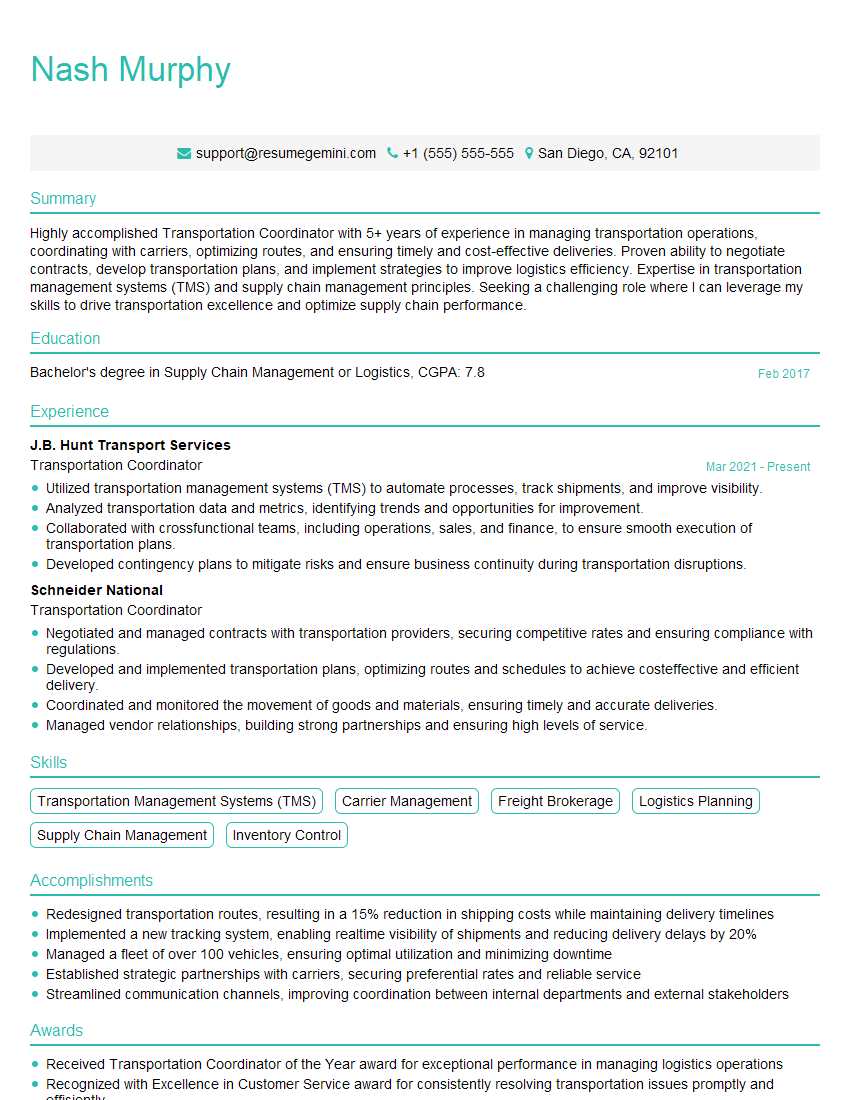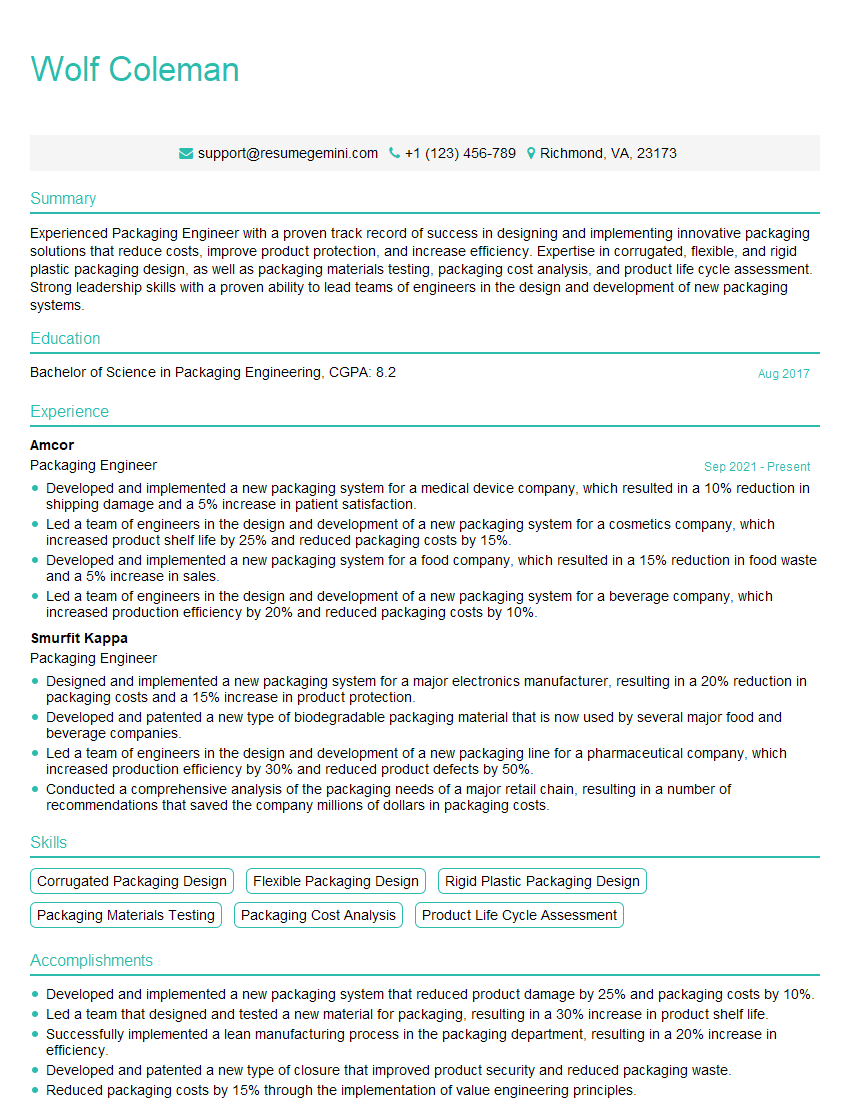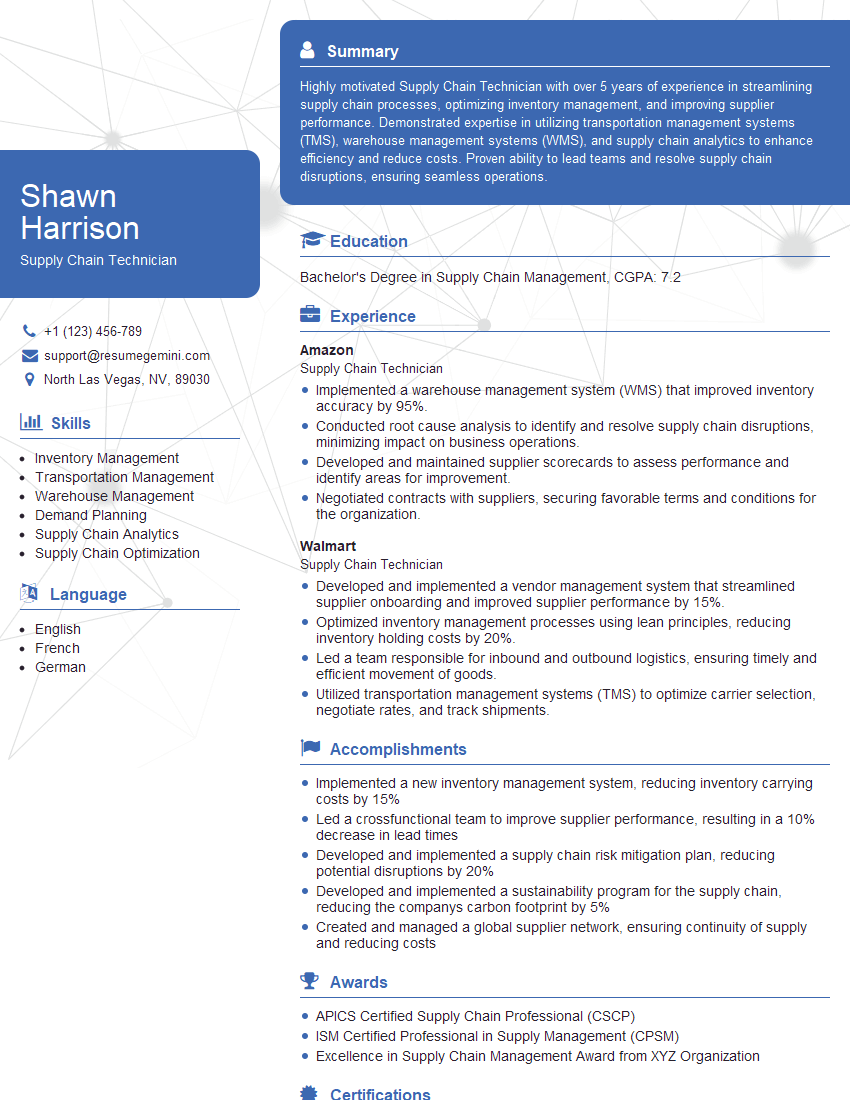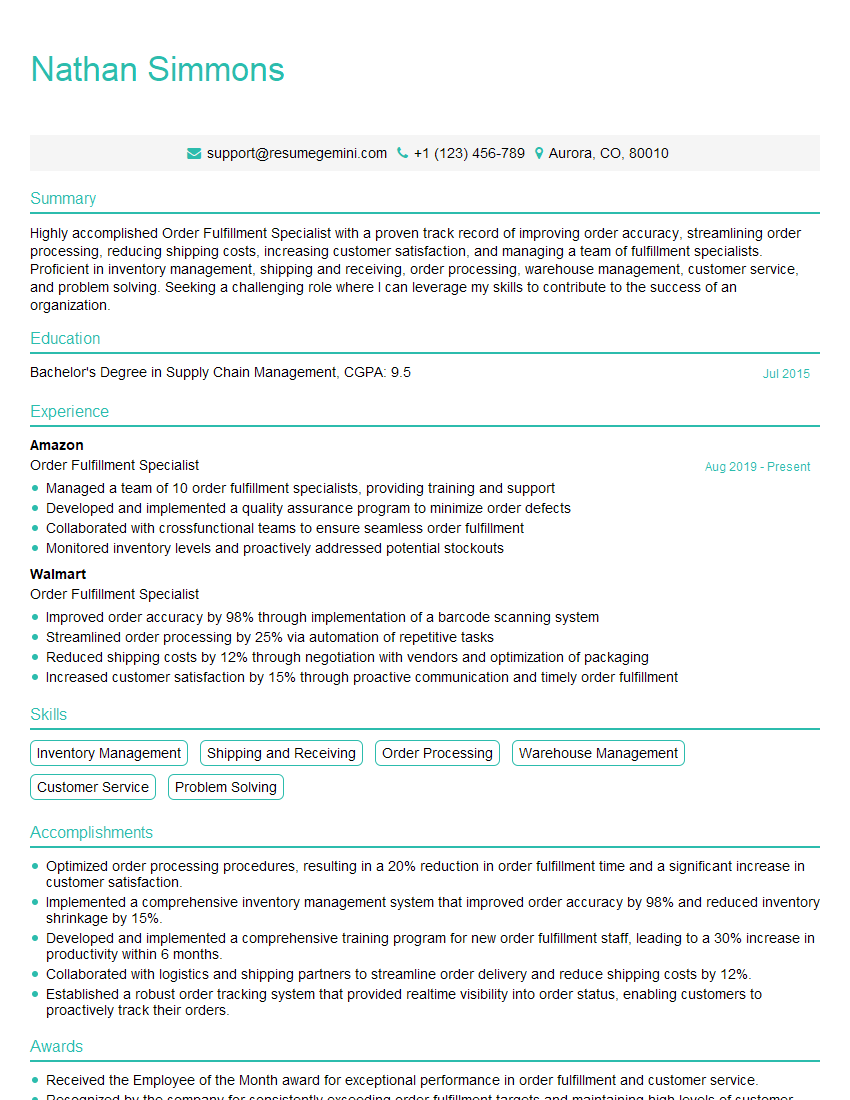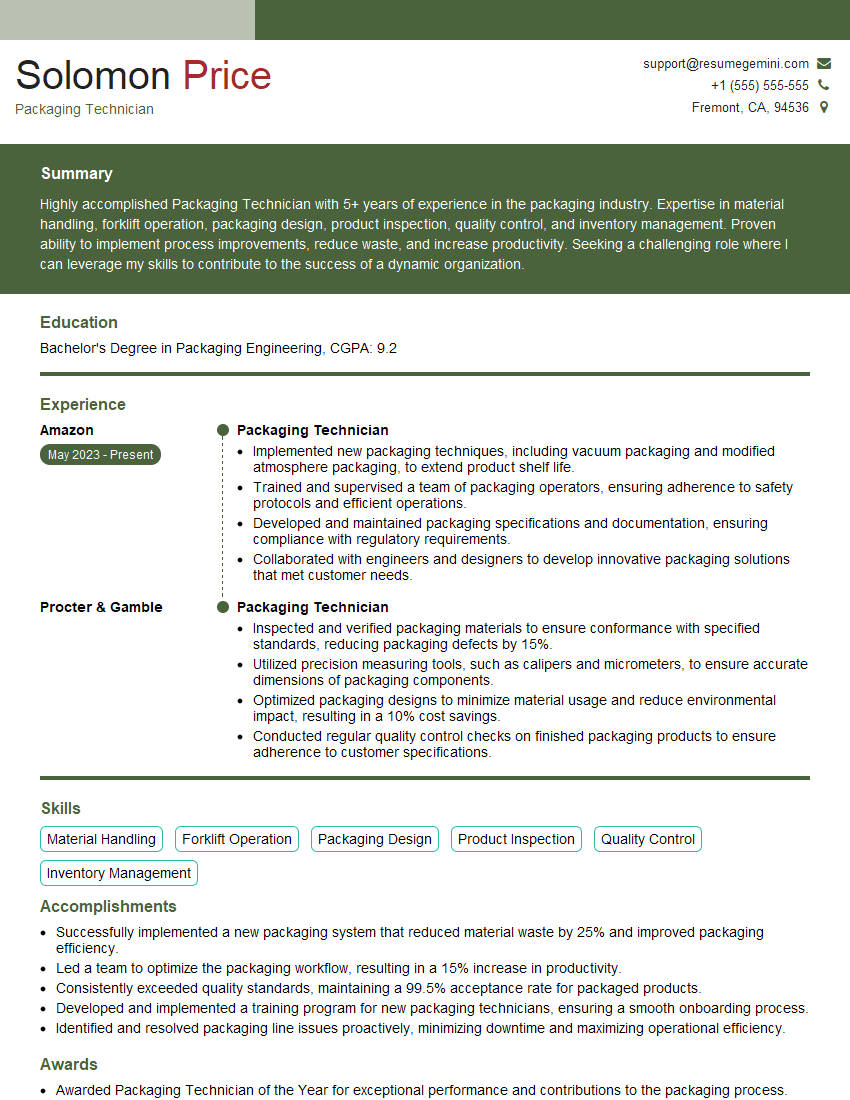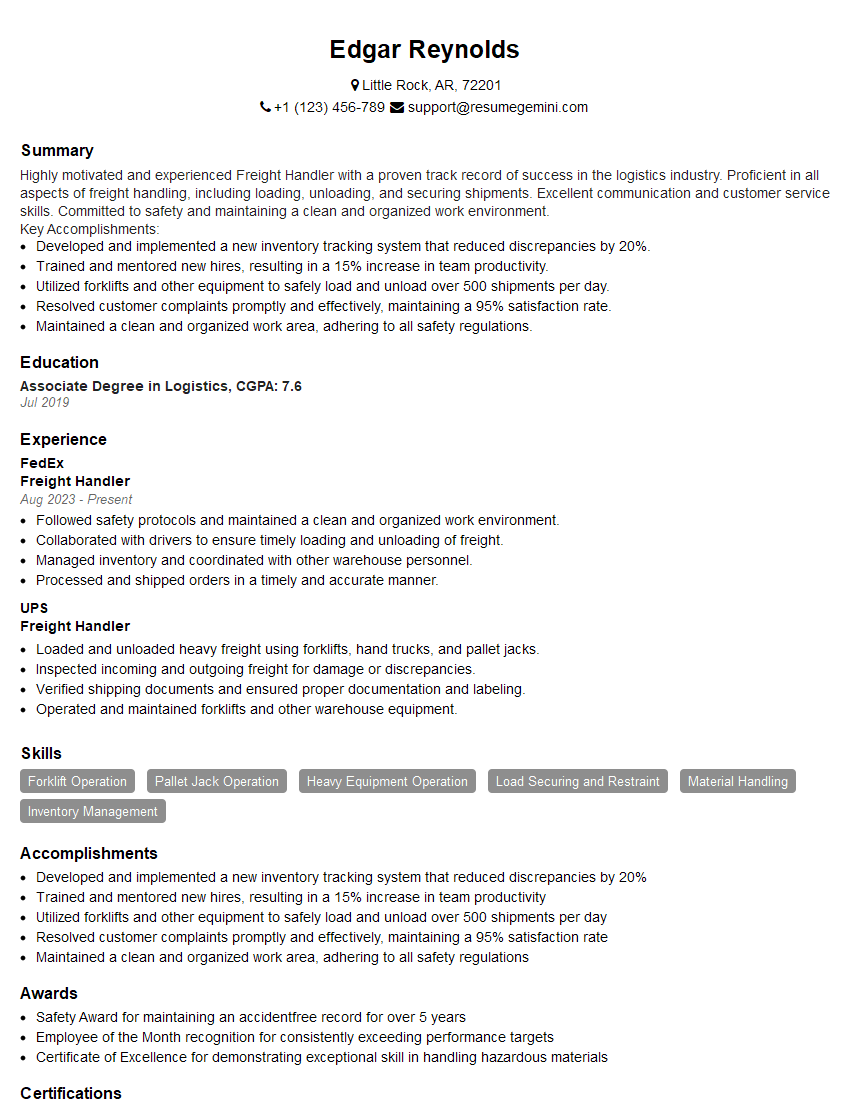Every successful interview starts with knowing what to expect. In this blog, we’ll take you through the top Crating and Uncrating interview questions, breaking them down with expert tips to help you deliver impactful answers. Step into your next interview fully prepared and ready to succeed.
Questions Asked in Crating and Uncrating Interview
Q 1. What are the different types of crating materials and when would you use each?
Choosing the right crating material is crucial for protecting your goods during shipping. The best material depends on the item’s fragility, weight, and the shipping environment. Here are some common options:
- Wood: The most robust option, offering excellent protection against impact and moisture. We use plywood or solid wood, depending on the item’s size and weight. For instance, a heavy piece of machinery might require a custom-built solid wood crate, while smaller, less delicate items might be adequately protected in a plywood crate.
- Particleboard/MDF: A more cost-effective alternative to wood, suitable for lighter and less fragile items. It’s often used for crating furniture or smaller electronics, but it’s not as durable as wood.
- Corrugated Cardboard: Excellent for lightweight and relatively non-fragile items. It’s easily accessible and cost-effective, but it’s not suitable for heavy or fragile items. Think of shipping smaller electronics or books in double-walled cardboard boxes.
- Plastic: Offers good protection against moisture and impact, suitable for items needing protection from the elements. Plastic crates are a good choice for items that need to be kept dry, but they are less adaptable than wood for irregularly shaped goods.
The selection process involves assessing the item’s characteristics and the shipping conditions, then choosing the material that provides the best balance of protection and cost-effectiveness.
Q 2. Explain the process of securing a crated item for shipping.
Securing a crated item is critical to prevent damage during transit. The process involves several key steps:
- Proper Padding: We start by using appropriate cushioning materials—foam, bubble wrap, packing peanuts, or air pillows—to fill any empty space within the crate and prevent the item from shifting during transit. The goal is to immobilize the item completely.
- Blocking and Bracing: This is where we use wood blocks or other solid materials to prevent the item from moving within the crate. We strategically place these blocks to secure the item against impacts from any direction. Think of it as building a cage around the item within the crate.
- Strapping: Once the item is securely blocked and braced, we use strong straps—either plastic or metal—to further reinforce the crate and prevent its walls from collapsing or the item from shifting. This adds an extra layer of security, especially for heavy items.
- Crate Closure: After strapping, we ensure the crate’s closure is secure. This may involve nailing, screwing, or using other appropriate fasteners, depending on the crate material. We always double-check for loose components.
- Labeling: Finally, we label the crate clearly with appropriate handling instructions (e.g., “FRAGILE,” “HANDLE WITH CARE,” “THIS WAY UP”) and the recipient’s information.
Each step is essential; a failure in any one can compromise the safety of the item during shipping.
Q 3. How do you determine the appropriate size crate for an item?
Determining the right crate size requires careful measurement and consideration of several factors:
- Item Dimensions: We start by precisely measuring the item’s length, width, and height, adding extra space around the item for padding and bracing.
- Padding Requirements: We account for the amount of padding needed to surround the item. More fragile items require more padding, increasing the necessary space.
- Shipping Regulations: We consider any size restrictions imposed by the shipping carrier or the destination country. Oversized items may incur additional charges or require special handling.
- Material Strength: The crate material’s strength determines the crate’s overall size. A smaller, stronger material (like solid wood) might be preferable to a larger, weaker material (like cardboard) for heavier items.
We often create a three-dimensional sketch of the crate design before construction, ensuring all dimensions are accurate and compliant with regulations. A crate that’s too small could damage the item, and one that’s too large can lead to unnecessary costs.
Q 4. What safety precautions do you take when crating and uncrating heavy items?
Safety is paramount when handling heavy items. We always prioritize the following:
- Proper Lifting Techniques: We use appropriate lifting equipment, such as forklifts or pallet jacks, for heavy crates. When manual lifting is unavoidable, we employ proper lifting techniques to avoid back injuries.
- Teamwork: For very heavy items, we use teamwork and communicate clearly to ensure safe and coordinated movements. Two or more people should lift together, maintaining proper posture and balance.
- Personal Protective Equipment (PPE): We wear appropriate PPE, including gloves, safety shoes, and sometimes back supports, to protect ourselves from potential hazards. Eye protection is also used, especially when using tools.
- Secure Work Area: We ensure the work area is clear of obstacles and has ample space for maneuvering heavy items. This minimizes the risk of accidents caused by tripping or collisions.
- Mechanical Aids: When possible, we use equipment like cranes or hoists for especially large or heavy crates to reduce the strain on workers.
We frequently review safety procedures and conduct risk assessments to proactively identify and mitigate potential hazards.
Q 5. Describe your experience with different types of packaging materials (e.g., foam, bubble wrap, etc.).
Experience with various packaging materials is essential for effective crating. Here’s my experience:
- Foam: Excellent for conforming to irregularly shaped items and providing cushioning against impacts. I’ve used both polyethylene and polyurethane foams, choosing the density appropriate for the item’s fragility and weight. For instance, high-density foam is better for heavier items.
- Bubble Wrap: A versatile and cost-effective option for cushioning smaller and lighter items. Its air pockets effectively absorb shocks. We use it as a secondary layer of protection, often in conjunction with other materials.
- Packing Peanuts: Suitable for filling void spaces within a crate and providing some cushioning. However, it’s less effective for protecting against significant impacts than foam or bubble wrap.
- Air Pillows: Inflatable pillows that provide excellent cushioning and can be easily customized to fit various spaces. They are lightweight and convenient, making them a good choice for shipping smaller items.
- Corrugated Paper: Often used as an additional layer of protection within a crate. It’s lightweight, biodegradable, and adds a level of cushioning.
The choice of material is guided by the item’s fragility, weight, and the shipping distance. We often use a combination of materials for optimal protection.
Q 6. How do you ensure the integrity of fragile items during crating?
Ensuring the integrity of fragile items requires a multi-layered approach:
- Custom-designed Crates: For extremely fragile items, we often design custom crates tailored to the item’s specific dimensions and fragility. This allows for a perfect fit and optimal protection.
- Multiple Layers of Cushioning: We use multiple layers of cushioning materials to absorb shocks and vibrations, often combining different materials for enhanced protection. A combination of foam and bubble wrap, for instance, provides excellent all-around protection.
- Suspension Systems: For especially fragile items, we sometimes incorporate suspension systems into the crate design. These systems reduce the transmission of impacts and vibrations to the item.
- Climate Control: For items sensitive to temperature or humidity, we might use climate-controlled containers or include desiccant packs to maintain stable conditions during shipping.
- Orientation Control: We clearly label the crate to indicate the correct orientation to maintain the item’s integrity. “THIS WAY UP” markings are essential.
The key is to anticipate potential damage points and mitigate them through appropriate design and materials.
Q 7. What are the common causes of damage during shipping and how can they be prevented?
Damage during shipping is often caused by several factors:
- Improper Handling: Rough handling by shipping personnel is a major culprit. This includes dropping, throwing, or stacking crates improperly.
- Insufficient Protection: Inadequate padding and bracing can leave items vulnerable to impacts and vibrations during transit.
- Inadequate Crating: Poorly constructed crates can collapse or break, leaving the item exposed to damage.
- Environmental Factors: Exposure to extreme temperatures, humidity, or moisture can damage certain types of goods.
- Accidents: Unforeseen events such as accidents during transport can cause significant damage.
Prevention involves proper crating techniques, clear labeling, using high-quality materials, and choosing reputable shipping carriers. Careful planning and attention to detail are key to minimizing damage.
Q 8. Explain your understanding of proper weight distribution within a crate.
Proper weight distribution in a crate is crucial for preventing damage during transit. Think of it like building a strong tower of blocks – you wouldn’t stack heavy blocks on top of lighter, weaker ones. The goal is to achieve a balanced center of gravity, minimizing stress on the crate’s structure and the items inside.
We achieve this by strategically placing heavier items towards the bottom and distributing weight evenly across the crate’s base. Lighter items are placed on top, filling any gaps to prevent shifting. For example, if crating heavy machinery components, the heaviest parts would form the base layer, secured with blocking and bracing. Smaller, less weighty parts would then be carefully placed on top, ensuring the overall center of gravity is low and stable.
This is often achieved using custom-designed inner bracing or partitions to separate items and prevent movement. Regularly checking weight distribution throughout the crating process is essential to ensure stability.
Q 9. How do you handle items with unusual shapes or sizes during crating?
Handling unusually shaped or sized items requires creative problem-solving and a good understanding of structural integrity. It’s like fitting pieces of a complex jigsaw puzzle – you need to find the best way to secure each piece while maximizing space efficiency and minimizing empty space.
We often use custom-fit inner packaging, such as foam inserts, to protect irregularly shaped items and hold them securely in place. For oversized items, we might need to use specialized blocking and bracing techniques to prevent movement and impact damage. We might also use extra-strong strapping or different crate materials to accommodate the unusual weight or dimensions.
For example, when crating a long, thin sculpture, we would use custom-built wooden supports running the length of the crate to prevent bending. Large, bulky objects might require a specially designed crate with reinforced corners and extra bracing to withstand the stresses of shipping. Careful planning and meticulous attention to detail are paramount in these scenarios.
Q 10. Describe your experience using different types of crating tools (e.g., strapping tools, nail guns, etc.).
My experience with crating tools is extensive, encompassing various types used for diverse projects. I’m proficient with pneumatic nail guns for securing wooden components, ensuring accurate and fast fastening without damaging the materials. I also have experience using electric staplers for lighter-duty work like attaching corrugated cardboard to create dividers.
I’m highly skilled in using various types of strapping tools, including manual and pneumatic tensioners, to create secure bonds using steel, polypropylene, or composite straps. This expertise allows me to choose the most suitable strapping material based on the item’s weight, dimensions, and shipping conditions. The choice between different strapping materials and the proper tensioning techniques are critical to ensuring the safety and security of the shipment.
Furthermore, I am familiar with the use of various hand tools, such as hammers, saws, and levels, for custom crating and bracing design, ensuring that the final crate is precisely constructed to protect the contents during transit.
Q 11. How do you ensure compliance with shipping regulations and labeling requirements?
Compliance with shipping regulations and labeling requirements is non-negotiable; it’s about ensuring safety and legal adherence. I’m intimately familiar with regulations such as those set forth by the International Air Transport Association (IATA) for air freight, and the International Maritime Organization (IMO) for sea freight. These regulations often cover aspects like handling of hazardous materials, weight limits, and appropriate labeling.
My process starts with identifying the specific regulations relevant to the shipment’s destination and mode of transport. I meticulously create accurate shipping labels, including details such as the sender and receiver information, weight, dimensions, contents, and any necessary hazard warnings. For hazardous materials, I ensure compliance with the required documentation, such as Safety Data Sheets (SDS) and proper packaging according to the relevant regulations.
Moreover, I maintain up-to-date knowledge of all relevant regulations and ensure all crating and labeling practices are in strict adherence to avoid delays and potential legal issues. Accurate documentation is key to ensuring smooth and legal transportation.
Q 12. What is your experience with hazardous materials packaging and handling?
Handling hazardous materials requires specialized knowledge and strict adherence to safety protocols. It’s not just about packaging; it’s about understanding the risks and mitigating them. I have extensive experience in handling and packaging various classes of hazardous materials, including those regulated under IATA and IMDG codes.
My experience encompasses proper selection of UN-certified packaging, which must meet specific strength and leakproof requirements. I’m proficient in using absorbent materials, specialized closures, and other protective measures to prevent spills or leaks. Accurate labeling and documentation are crucial, adhering strictly to international regulations to ensure safety during transportation.
For instance, when packaging corrosive materials, I would use secondary containment packaging and specialized liners to prevent leaks and corrosion of the packaging itself. This attention to detail minimizes risk to personnel and the environment.
Q 13. Describe a time you had to troubleshoot a crating or uncrating problem.
During a recent project involving the crating of a delicate antique clock, we encountered a problem with excessive vibration during transit testing. The clock, despite being well-padded, showed signs of potential damage. The problem wasn’t immediately apparent.
We systematically investigated potential causes, starting with analyzing the crate’s design. We realized that the internal bracing, while seemingly sufficient, lacked sufficient rigidity to counteract the resonant frequencies that were causing the vibrations. We implemented additional bracing and used vibration-dampening materials to create a more rigid and shock-absorbing internal structure.
This involved adding strategically placed wooden supports and using specialized vibration-dampening pads to absorb and dissipate the vibrations during transit. Retesting confirmed the effectiveness of these changes. The clock was successfully transported without any damage. This experience highlighted the importance of meticulous planning and thorough testing to prevent unforeseen issues.
Q 14. How do you identify and address potential damage to items during uncrating?
Identifying and addressing potential damage during uncrating requires a careful, methodical approach. It’s about being observant and taking proactive measures to minimize further harm.
The process begins with a thorough visual inspection of the crate’s exterior for any signs of damage like crushing, punctures, or significant wear. Then, we carefully open the crate, taking note of the condition of internal bracing and any signs of shifting or impact. Each item is then inspected for any damage, from minor scratches to more substantial breaks.
Documentation of damage, including photographic evidence, is crucial. We use a damage report form to record details, which helps with potential insurance claims or communication with clients. For any damaged items, we implement appropriate handling techniques to avoid further damage during removal and subsequent repairs.
Q 15. What is your experience with inventory management related to crating and uncrating?
Inventory management in crating and uncrating is crucial for efficiency and accuracy. It involves meticulously tracking every item, from the initial inventory count before crating, through the crating process itself, and finally, after uncrating. This ensures no items are lost or damaged during transit. My approach involves using a combination of barcoding, RFID tagging (Radio-Frequency Identification), or even a simple, well-maintained spreadsheet, depending on the project’s scale and client requirements. For larger projects, I’ve successfully integrated inventory management software to automate tracking and reporting, providing real-time visibility into the location and status of each item. For instance, on a recent project involving the crating of delicate museum artifacts, we used RFID tags to track each piece individually, ensuring that everything arrived safely and accounted for at its destination. This minimized the risk of loss or misplacement and provided comprehensive documentation for insurance purposes.
Specific strategies I employ include regular stock checks during the crating process, detailed labelling of each crate with contents and item counts, and the diligent reconciliation of inventory upon uncrating. This rigorous approach ensures accountability and transparency throughout the entire process.
Career Expert Tips:
- Ace those interviews! Prepare effectively by reviewing the Top 50 Most Common Interview Questions on ResumeGemini.
- Navigate your job search with confidence! Explore a wide range of Career Tips on ResumeGemini. Learn about common challenges and recommendations to overcome them.
- Craft the perfect resume! Master the Art of Resume Writing with ResumeGemini’s guide. Showcase your unique qualifications and achievements effectively.
- Don’t miss out on holiday savings! Build your dream resume with ResumeGemini’s ATS optimized templates.
Q 16. How do you maintain a clean and organized workspace while crating and uncrating?
Maintaining a clean and organized workspace is paramount for safety, efficiency, and professionalism in crating and uncrating. Think of it like a well-organized kitchen – you can’t cook a good meal in a chaotic space. My approach involves a systematic process. Before starting any project, I ensure the workspace is clear of obstructions. I designate specific areas for different materials: packing materials, tools, and finished crates. As I work, I constantly remove debris and discard waste materials immediately. Tools are kept in designated locations to prevent accidents and to streamline workflows. This systematic approach reduces the risk of damage to goods, injuries, and wasted time searching for tools or materials. Proper disposal of waste materials also adheres to environmental regulations and promotes a positive work environment.
For larger projects, I implement a color-coded system for different materials or stages of crating to further improve organization and speed up the process.
Q 17. What are your skills in reading and interpreting shipping documents?
Reading and interpreting shipping documents is fundamental to my work. These documents provide critical information on the shipment’s origin, destination, contents, handling instructions, and any relevant regulations. I’m proficient in reading bills of lading, packing lists, commercial invoices, certificates of origin, and other related documents. I understand the importance of identifying hazardous materials classifications (e.g., UN numbers) and adhering to regulations set by bodies like the International Maritime Organization (IMO) or the Department of Transportation (DOT). Any discrepancies or missing information are immediately flagged to prevent delays or compliance issues. For example, if a shipping document indicates fragile contents but doesn’t specify handling instructions, I would proactively contact the client for clarification to avoid potential damage during transit.
Q 18. Explain your experience with different types of shipping methods (e.g., LTL, FTL).
My experience encompasses various shipping methods, including Less-than-Truckload (LTL) and Full Truckload (FTL) shipments. LTL is cost-effective for smaller shipments, where space is shared with other consignments. FTL offers greater control and security for larger or high-value shipments, as it dedicates an entire truck to a single consignment. The choice depends on factors like volume, value, and urgency. Understanding these methods allows me to optimize the crating process to ensure compatibility with the chosen shipping mode. For instance, LTL shipments require crates that are easily handled and stacked, while FTL shipments may allow for larger, less maneuverable crates. I also have experience with other methods such as air freight and sea freight, each requiring specific crating considerations to ensure the safety of goods during transit.
Q 19. What is your experience working with different types of customers or clients?
I’ve worked with a diverse range of customers and clients, from small businesses to large corporations and government agencies. My experience includes working with art galleries (requiring meticulous handling of fragile artwork), manufacturing companies (needing robust crating for heavy machinery), and research institutions (demanding specialized crating solutions for sensitive equipment). I understand that each client has unique needs and priorities, and I adapt my approach accordingly. Effective communication and proactive problem-solving are crucial in managing expectations and building strong client relationships. For example, for a client shipping sensitive scientific equipment overseas, I coordinated with customs brokers to ensure compliance with all international regulations, including proper documentation and labeling.
Q 20. Describe your experience with custom crating solutions.
Custom crating solutions are often necessary to protect unique or valuable items. My expertise lies in designing and building crates tailored to specific client requirements. This involves assessing the item’s dimensions, weight, fragility, and environmental sensitivities. I use a variety of materials, including wood, plywood, foam, and specialized cushioning, depending on the product’s needs. For example, I designed a custom-built crate with internal shock absorbers for a client shipping a delicate antique clock. I collaborate closely with clients to understand their needs and provide cost-effective solutions. CAD software often plays a part in the design phase, enabling detailed visualization and precise material estimations.
Q 21. How do you ensure the efficiency of the crating and uncrating process?
Efficiency in crating and uncrating is achieved through a combination of careful planning, optimized processes, and the right tools. This begins with a thorough assessment of the items to be crated, including their dimensions, weight, and fragility. This informs the selection of appropriate packing materials and crating techniques. I emphasize using ergonomic techniques to reduce strain and improve speed. Pre-assembled packing materials and standardized procedures significantly reduce the time needed to complete the job. Regularly maintaining equipment and having a readily available supply of necessary materials also helps prevent delays. The implementation of standardized procedures and checklists ensures consistent quality and reduces errors. Regularly reviewing and refining the process is essential to identify and resolve bottlenecks, ultimately maximizing efficiency.
Q 22. How do you manage your time and prioritize tasks while working on multiple projects?
Managing time effectively across multiple crating and uncrating projects requires a structured approach. I utilize project management tools, like Kanban boards or Gantt charts, to visualize tasks and deadlines. This allows me to prioritize based on urgency and dependencies. For example, a high-priority rush order for fragile medical equipment would take precedence over a standard shipment of less sensitive goods. I also break down large projects into smaller, manageable tasks, creating a more achievable workflow. Regular review and adjustment of the schedule are critical to adapt to unforeseen delays or changing priorities. Think of it like conducting an orchestra – each instrument (task) needs to play its part at the right time for a harmonious outcome (successful project completion).
Q 23. What is your experience with using inventory management systems?
My experience with inventory management systems is extensive. I’m proficient in using both basic spreadsheet-based systems and more advanced software solutions like [mention specific software, e.g., Fishbowl Inventory, Cin7]. I understand the importance of accurate data entry for tracking inventory levels, material costs, and overall project profitability. For instance, using a system to track the type and quantity of wood, foam, and other packing materials allows for timely reordering and prevents delays. Furthermore, integrating inventory management with project management tools enables better resource allocation and prevents overstocking or shortages.
Q 24. How do you maintain accurate records of crating and uncrating activities?
Maintaining accurate records is paramount in our field. I meticulously document each step of the crating and uncrating process. This includes detailed inventory lists of items being crated, photographs of the crated goods (both before and after shipment), bills of materials used, and timestamps for every activity. All this information is neatly organized and stored electronically (in a secure cloud storage and/or company server) and backed up regularly. We also use barcodes or RFID tags in some cases for efficient tracking and verification. For example, a detailed record of a fragile antique being crated would include its dimensions, weight, materials used for protection, insurance details, and a clear photo of the packaging.
Q 25. Describe your experience with quality control checks during crating and uncrating.
Quality control is integral to preventing damage and ensuring client satisfaction. My approach involves multiple checkpoints. Before crating, I inspect the goods for existing damage. During the crating process, I ensure appropriate padding and bracing are used, always considering the fragility and weight of items. After crating, I conduct a final inspection to ensure the crate is structurally sound and properly labeled. Furthermore, upon uncrating, I meticulously check for any damage incurred during transit. I document all findings, and any damages are reported immediately to the relevant parties. A checklist system helps standardize this procedure and guarantees consistency across all projects.
Q 26. How do you adapt your techniques to different types of goods and client requirements?
Adaptability is key in this profession. Different goods require different handling and packaging techniques. For example, fragile electronics require specialized anti-static packaging and careful bracing, whereas heavier machinery needs robust crates and reinforced structures. Client requirements also play a significant role. Some clients might require specific types of materials or labeling, while others may have unique shipping instructions. My approach involves understanding the client’s needs and the nature of the goods before finalizing the crating plan. Open communication and careful planning prevent issues and ensure client satisfaction.
Q 27. Describe your experience using specialized equipment for crating and uncrating (e.g., forklifts, pallet jacks).
I’m experienced in operating various specialized equipment, including forklifts, pallet jacks, and hand trucks. I’m certified in their safe operation, adhering strictly to all safety regulations. Forklifts are used for moving heavy crates efficiently, while pallet jacks are utilized for smaller, lighter crates. Hand trucks are indispensable for maneuvering crates in tighter spaces or during loading/unloading. Proficiency in using this equipment increases efficiency and reduces the risk of accidents or damage to the goods. I prioritize safety measures at all times, using appropriate safety gear and ensuring proper procedures are followed.
Q 28. How do you handle situations where there is a discrepancy between the contents of a crate and the shipping documents?
Discrepancies between crate contents and shipping documents are handled immediately and systematically. First, I carefully recount and verify the contents of the crate. Then, I cross-reference this information with the original inventory list and the shipping documents. If a discrepancy is confirmed, I document the discrepancy meticulously, noting any missing or extra items. Photographs are crucial evidence. I then inform my supervisor and the client immediately, providing detailed documentation of the issue. Depending on the nature of the discrepancy, I follow established company procedures, which may involve further investigation, insurance claims, or corrective actions. Transparency and timely communication are paramount in resolving such situations.
Key Topics to Learn for Crating and Uncrating Interview
- Material Handling Techniques: Understanding proper lifting techniques, weight distribution, and the use of appropriate equipment (e.g., hand trucks, dollies) for safe and efficient handling of crates and their contents.
- Packaging Materials and Their Properties: Familiarity with different types of packaging materials (wood, cardboard, plastic, etc.), their strengths, weaknesses, and suitability for various goods. Understanding how to select appropriate materials for optimal protection during transit.
- Crating Design and Construction: Knowledge of basic crate construction principles, including bracing, reinforcement, and securing methods to prevent damage during shipping and handling. This includes understanding different types of crates and their applications.
- Inventory Management and Organization: Efficient methods for tracking and managing inventory within a crating and uncrating environment. Understanding inventory control systems and their importance in maintaining order and accuracy.
- Safety Procedures and Regulations: Comprehensive understanding of workplace safety regulations, hazard identification, and risk mitigation strategies related to crating and uncrating operations. Proper use of personal protective equipment (PPE).
- Damage Prevention and Assessment: Identifying potential damage risks during the crating and uncrating process and implementing preventative measures. Assessing damage if it occurs and reporting procedures.
- Uncrating Procedures and Techniques: Safe and efficient methods for uncrating goods, including the proper use of tools and techniques to avoid damage to the product and the surrounding environment.
- Compliance and Documentation: Understanding relevant industry regulations, standards, and documentation requirements for crating and uncrating processes (e.g., shipping manifests, inspection reports).
Next Steps
Mastering crating and uncrating techniques is crucial for career advancement in logistics, warehousing, and shipping. Proficiency in these skills demonstrates your ability to handle goods safely and efficiently, a highly valuable asset in many industries. To significantly boost your job prospects, creating a strong, ATS-friendly resume is essential. ResumeGemini is a trusted resource to help you build a professional and effective resume that highlights your skills and experience. Examples of resumes tailored to Crating and Uncrating roles are available to help guide your resume building process.
Explore more articles
Users Rating of Our Blogs
Share Your Experience
We value your feedback! Please rate our content and share your thoughts (optional).
What Readers Say About Our Blog
Hello,
We found issues with your domain’s email setup that may be sending your messages to spam or blocking them completely. InboxShield Mini shows you how to fix it in minutes — no tech skills required.
Scan your domain now for details: https://inboxshield-mini.com/
— Adam @ InboxShield Mini
Reply STOP to unsubscribe
Hi, are you owner of interviewgemini.com? What if I told you I could help you find extra time in your schedule, reconnect with leads you didn’t even realize you missed, and bring in more “I want to work with you” conversations, without increasing your ad spend or hiring a full-time employee?
All with a flexible, budget-friendly service that could easily pay for itself. Sounds good?
Would it be nice to jump on a quick 10-minute call so I can show you exactly how we make this work?
Best,
Hapei
Marketing Director
Hey, I know you’re the owner of interviewgemini.com. I’ll be quick.
Fundraising for your business is tough and time-consuming. We make it easier by guaranteeing two private investor meetings each month, for six months. No demos, no pitch events – just direct introductions to active investors matched to your startup.
If youR17;re raising, this could help you build real momentum. Want me to send more info?
Hi, I represent an SEO company that specialises in getting you AI citations and higher rankings on Google. I’d like to offer you a 100% free SEO audit for your website. Would you be interested?
Hi, I represent an SEO company that specialises in getting you AI citations and higher rankings on Google. I’d like to offer you a 100% free SEO audit for your website. Would you be interested?
good


